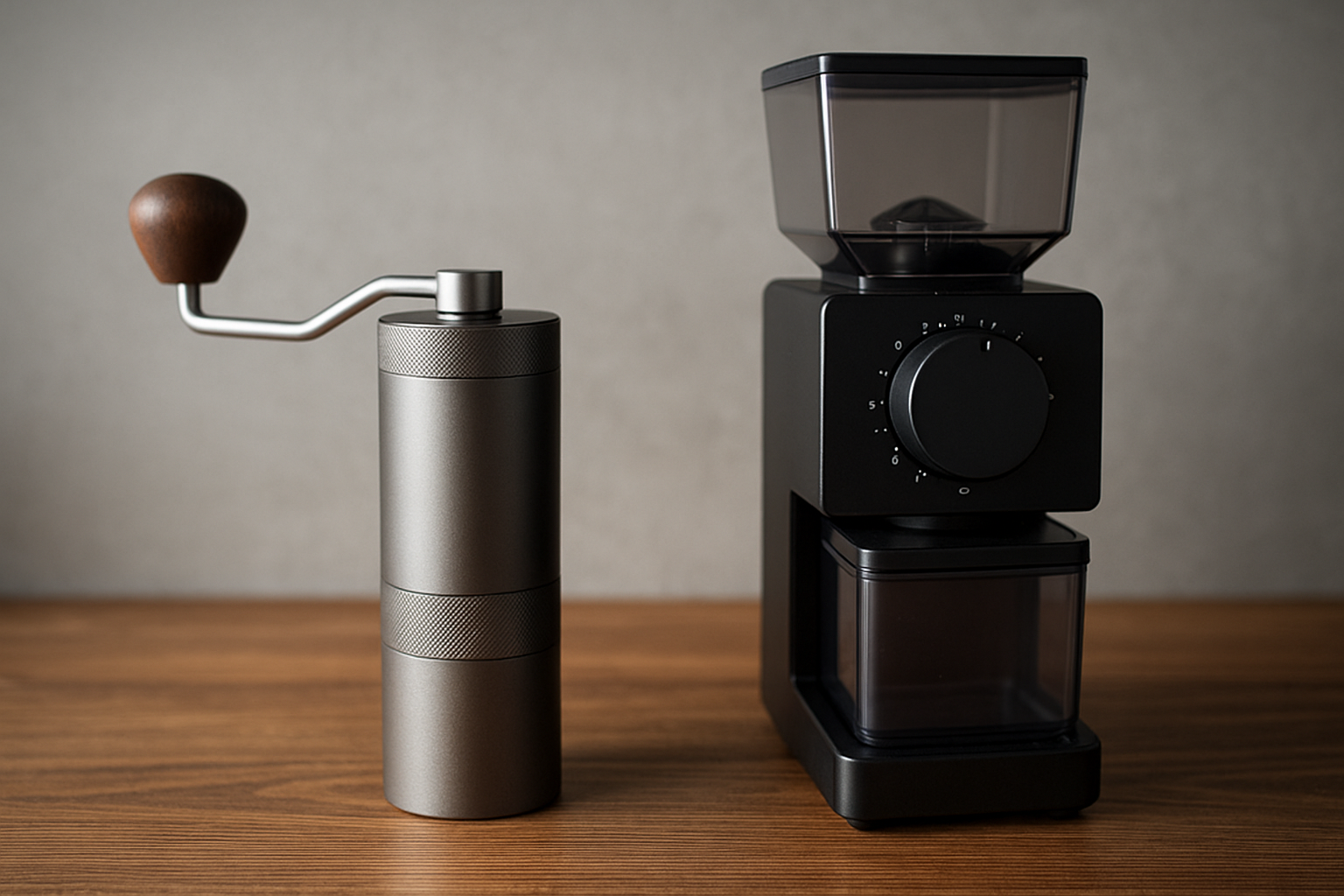If you’re serious about coffee, the grinder you choose matters just as much as your brewing method. Grinding your own beans just before brewing maximizes freshness and unlocks the full spectrum of flavor in every cup. But when it comes to choosing a grinder, one major question stands out: manual or electric?
In 2025, both options have become more advanced, accessible, and diverse than ever. From sleek hand grinders with premium burrs to smart electric models with app connectivity, the choice isn’t just about convenience—it’s about control, consistency, and cost.
This guide will help you decide which type of grinder is the right fit for your coffee routine by breaking down the pros and cons of each, examining performance, and considering practical lifestyle factors.
Why Grinding Fresh Coffee Matters
Before we dive into the comparison, let’s briefly recap why grinding your own beans is essential:
- Preserves aroma and flavor: Coffee begins to oxidize quickly after grinding.
- Lets you control grind size: Crucial for matching your grind to your brew method.
- Maximizes freshness: Whole beans retain their character longer than pre-ground coffee.
- Improves consistency: Especially when paired with the right burr grinder.
Now that we’ve established the “why,” let’s get into the “how.”
What Is a Manual Coffee Grinder?
A manual grinder, or hand grinder, uses a rotating burr mechanism that’s powered by your arm. It usually consists of:
- A bean hopper
- Adjustable burrs (ceramic or steel)
- A hand crank
- A grounds container
Manual grinders have come a long way and now include premium models that rival electric grinders in consistency.
Pros of Manual Grinders
- Affordability: Great manual grinders can cost as little as $30–$70.
- Portability: No need for electricity—perfect for travel, camping, or office use.
- Quiet operation: Ideal for early mornings or shared spaces.
- Durability: Fewer moving parts and no motor to burn out.
- More ritualistic: Many coffee lovers enjoy the hands-on process.
Cons of Manual Grinders
- Physical effort: Grinding for espresso or large batches can be tiring.
- Takes time: Around 1–2 minutes per brew, depending on grind size and quantity.
- Smaller capacity: Not great if you brew for a crowd.
- Inconsistent quality: Budget models may lack burr alignment or precision.
What Is an Electric Coffee Grinder?
Electric grinders use a motor to power burrs or blades that grind coffee automatically. Higher-end models often come with programmable settings, timers, and display panels.
There are two main types:
- Blade grinders (not recommended): Use spinning blades, which chop rather than grind. Inconsistent results.
- Burr grinders (recommended): Use flat or conical burrs to crush beans evenly.
Pros of Electric Grinders
- Speed: Grinds a full dose in seconds.
- Ease of use: Just press a button or use a timer.
- Precision and consistency: Especially with quality burr grinders.
- Larger capacity: Better for households or frequent hosts.
- Multiple settings: Some offer 30+ grind adjustments, ideal for switching between brew methods.
Cons of Electric Grinders
- Price: Quality electric burr grinders typically start around $100–$150 and can exceed $500.
- Noise: Louder than manual options—can be disruptive early in the morning.
- Size: Requires counter space and often isn’t portable.
- Maintenance: More components mean more things that can break or need cleaning.
Grind Consistency: The Make-or-Break Factor
The key to great coffee is consistent grind size. This affects how evenly your coffee extracts, which in turn impacts flavor and balance.
- Manual Grinders: Mid- to high-end hand grinders (like the 1Zpresso or Timemore Chestnut) offer remarkable grind consistency, rivaling electric models in the $300+ range. Lower-end ones may struggle with alignment and retention.
- Electric Grinders: Offer better consistency in cheaper models (e.g., Baratza Encore) than manual grinders in the same price range. However, burr size and RPM matter—a $300 grinder will dramatically outperform a $100 one.
If you brew espresso, where precision is everything, electric grinders generally win unless you invest in a high-end manual espresso grinder.
Best Use Cases for Manual Grinders
Choose a manual grinder if you:
- Prefer pour-over, French press, or AeroPress
- Travel or camp often
- Live in a small space or value minimalism
- Enjoy the meditative ritual of grinding by hand
- Want high quality without a high price tag
They’re especially well-suited to single-cup brewing and low-tech setups.
Best Use Cases for Electric Grinders
Choose an electric grinder if you:
- Brew espresso regularly
- Make multiple cups daily
- Value speed and convenience
- Need precision across multiple grind sizes
- Don’t mind a higher investment for efficiency
Electric grinders shine in busy households, home cafés, or anyone experimenting with espresso, Chemex, or multiple brew methods.
Price Comparison in 2025
| Type | Entry Level | Mid-Range | High-End |
|---|---|---|---|
| Manual Grinder | $30–$60 | $80–$150 | $150–$250 (espresso) |
| Electric Burr Grinder | $100–$150 | $200–$400 | $500+ (pro-level) |
Manual grinders give you more bang for your buck at lower price points, while electric grinders offer more features and scale at higher prices.
Maintenance and Durability
Manual grinders tend to last longer with minimal upkeep. Cleaning involves disassembling a few parts, brushing out residual grounds, and occasionally washing burrs.
Electric grinders require:
- More frequent cleaning due to static and retention
- Occasional recalibration
- Replacing burrs after 250–500 lbs of beans (depending on quality)
Keep in mind that electronics may fail before burrs wear out, especially in cheaper models.
Aesthetic and Experience
There’s something beautiful about both styles.
- Manual grinders are often minimal, tactile, and satisfying to use. Many feature wood, steel, or matte finishes and look good on any counter.
- Electric grinders, while bulkier, add tech flair to your setup—timers, touchscreens, and smart dosing features offer precision with style.
Your preference might come down to how much you value experience versus efficiency.
Final Verdict: Which Grinder Should You Buy in 2025?
There’s no universal answer—only what’s right for your lifestyle and brewing goals.
Choose manual if:
- You value craftsmanship and don’t mind a little effort.
- You’re on a budget but still want quality results.
- You’re brewing for one or two and love ritual.
Choose electric if:
- You prioritize speed and convenience.
- You brew espresso or multiple cups daily.
- You’re ready to invest in consistent, high-quality output.
Ultimately, both can produce excellent coffee. The key is matching your grinder to your habits, not just your wishlist. Whichever you choose, you’ll take a huge step forward in your coffee journey by grinding fresh and taking control of your brew.

